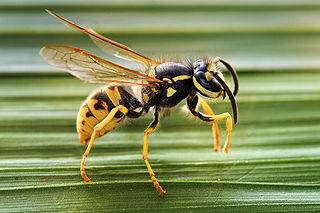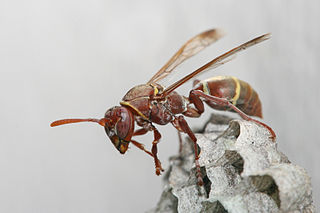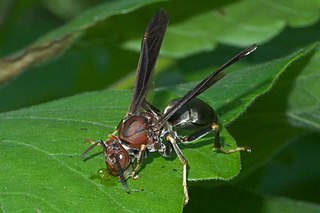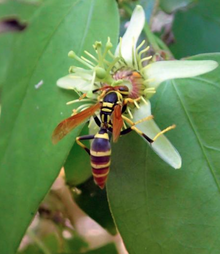
The Vespidae are a large, diverse, cosmopolitan family of wasps, including nearly all the known eusocial wasps and many solitary wasps. Each social wasp colony includes a queen and a number of female workers with varying degrees of sterility relative to the queen. In temperate social species, colonies usually last only one year, dying at the onset of winter. New queens and males (drones) are produced towards the end of the summer, and after mating, the queens hibernate over winter in cracks or other sheltered locations. The nests of most species are constructed out of mud, but polistines and vespines use plant fibers, chewed to form a sort of paper. Many species are pollen vectors contributing to the pollination of several plants, being potential or even effective pollinators, while others are notable predators of pest insect species, and a few species are invasive pests.

The great crested flycatcher is a large insect-eating bird of the tyrant flycatcher family. It is the most widespread member of the genus Myiarchus in North America, and is found over most of the eastern and mid-western portions of the continent. It dwells mostly in the treetops and rarely is found on the ground.

Paper wasps are vespid wasps and typically refers to members of the vespid subfamily Polistinae, though it often colloquially includes members of the subfamilies Vespinae and Stenogastrinae, discussed elsewhere, which also make nests out of paper. Paper wasp nests are characterized by open combs with down pointing cells. Some types of paper wasps are also sometimes called umbrella wasps, due to the distinctive design of their nests.

Polistes is a cosmopolitan genus of paper wasps and the only genus in the tribe Polistini. Vernacular names for the genus include umbrella wasps, coined by Walter Ebeling in 1975 to distinguish it from other types of paper wasp, in reference to the form of their nests, and umbrella paper wasps. Polistes is the single largest genus within the family Vespidae, with over 200 recognized species. Their innate preferences for nest-building sites leads them to commonly build nests on human habitation, where they can be very unwelcome; although generally not aggressive, they can be provoked into defending their nests. All species are predatory, and they may consume large numbers of caterpillars, in which respect they are generally considered beneficial.

The Polistinae is a subfamily of eusocial wasps belonging to the family Vespidae. They are closely related to the wasps and true hornets of the subfamily Vespinae, containing four tribes. With about 1,100 species total, it is the second-most diverse subfamily within the Vespidae, and while most species are tropical or subtropical, they include some of the most frequently encountered large wasps in temperate regions.

Oophagy or ovophagy, literally "egg eating", is the practice of embryos feeding on eggs produced by the ovary while still inside the mother's uterus. The word oophagy is formed from the classical Greek ᾠόν and classical Greek φᾱγεῖν. In contrast, adelphophagy is the cannibalism of a multi-celled embryo.

The European paper wasp is one of the most common and well-known species of social wasps in the genus Polistes. Its diet is more diverse than those of most Polistes species—many genera of insects versus mainly caterpillars in other Polistes—giving it superior survivability compared to other wasp species during a shortage of resources.
The canyon mouse is a gray-brown mouse found in many states of the western United States and northern Mexico. Its preferred habitat is arid, rocky desert. Vegetation has little or no effect on the distribution of canyon mice, it is instead associated with rocky substrate than any plant. Canyon mice forage in areas with shrub-like vegetation which can be used for protection against predators. It is the only species in the Peromyscus crinitus species group.

Polistes humilis, known as the Australian paper wasp, is a species of wasp in the family Vespidae that is found throughout Australia and which has been introduced to northern New Zealand. These paper wasps can be identified by their long thin legs and banded yellow and black coloring. They have been known to re-utilize old nests. While the species does not exhibit morphological class differences, there are distinct behavioral differences between queens and workers. In addition, the species is eusocial and benefits from relatedness between individuals. They are known for delivering a painful sting, especially when their nest is disturbed, a behavior that has been developed as a nest defense mechanism. While wasps are often viewed negatively, they play an important pollination role for many plants.
Taeniodictys is a monotypic moth genus belonging to the family Lyonetiidae described by William Trowbridge Merrifield Forbes in 1933. It contains only one species, Taeniodictys sericella, described by the same author in the same year, which is found in Puerto Rico.

Polistes annularis is a species of paper wasp found throughout the eastern half of the United States. This species of red paper wasp is known for its large size and its red-and-black coloration and is variably referred to as a ringed paper wasp or jack Spaniard wasp. It builds its nest under overhangs near bodies of water that minimize the amount of sunlight penetration. It clusters its nests together in large aggregations, and consumes nectar and other insects. Its principal predator is the ant, although birds are also known to prey on it. Unlike other wasps, P. annularis is relatively robust in winter conditions, and has also been observed to store honey in advance of hibernation. This species has also been used as a model species to demonstrate the ability to use microsatellite markers in maternity assignment of social insects.

Polistes metricus is a wasp native to North America. In the United States, it ranges throughout the southern Midwest, the South, and as far northeast as New York, but has recently been spotted in southwest Ontario. A single female specimen has also been reported from Dryden, Maine. Polistes metricus is dark colored, with yellow tarsi and black tibia. Nests of Polistes metricus can be found attached to the sides of buildings, trees, and shrubbery.

Polistes exclamans, the Guinea paper wasp, is a social wasp and is part of the family Vespidae of the order Hymenoptera. It is found throughout the United States, Mexico, the Bahamas, Jamaica and parts of Canada. Due to solitary nest founding by queens, P. exclamans has extended its range in the past few decades and now covers the eastern half of the United States, as well as part of the north. This expansion is typically attributed to changing global climate and temperatures. P. exclamans has three specific castes, including males, workers, and queens, but the dominance hierarchy is further distinguished by age. The older the wasp is, the higher it is in ranking within the colony. In most P. exclamans nests, there is one queen who lays all the eggs in the colony. The physiological similarities between the worker and queen castes have led to experiments attempting to distinguish the characteristics of these two castes and how they are determined, though males have easily identifiable physiological characteristics. Since P. exclamans live in relatively small, open combed nests, they are often subject to predators and parasites, such as Chalcoela iphitalis, Elasmus polistis, and birds. P. exclamans have defense and recognition strategies that help protect against these predators and parasites.

Polistes carnifex, commonly known as the executioner wasp or executioner paper wasp, is a neotropical vespid wasp in the cosmopolitan genus Polistes.

Polistes canadensis is a species of red paper wasp found in the Neotropical realm. It is a primitively eusocial wasp as a member of the subfamily Polistinae. A largely predatory species, it hunts for caterpillar meat to supply its colony, often supplementing its developing larvae with nectar. The most widely distributed American species of the genus Polistes, it colonizes multiple combs, which it rears year-round.
The name cuckoo paper wasp refers to a monophyletic species group of brood-parasitic paper wasps in the genus Polistes. This species group contains only four species; Polistes atrimandibularis, P. austroccidentalis, P. maroccanus, and P. semenowi, all of them obligate social parasites of other Polistes species.
Polistes crinitus crinitus is a subspecies of Polistes crinitus that lives on small Caribbean islands.
Polistes crinitus americanus is a subspecies of Polistes crinitus that lives on small Caribbean islands.
Polistes crinitus multicolor is a subspecies of Polistes crinitus that lives on small Caribbean islands.

Polistes bahamensis is a large species of colourful paper wasp in the genus Polistes of the family Vespidae which occurs in the Bahamas, Florida and Louisiana. It is also said to occur in Georgia.














